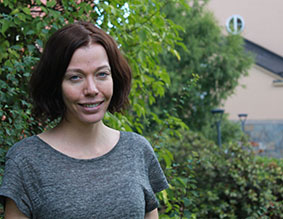How do bank runs arise?
Sara Jonsson, researcher at the Centre for Banking and Finance, is studying what are known as bank runs. To investigate what mechanisms give rise to savers who no longer trust the bank suddenly withdrawing all of their money, Sara has studied the economic crisis in Cyprus.

"When the situation arose in Cyprus, I decided to include this as a case study in my project. It presented a unique opportunity to study a potential bank run, so I went there in order to, among other things, prepare the data collection."
In the beginning of 2013, the banking crisis in Cyprus was a fact. The European Central Bank granted emergency loans and, when these funds ran dry, the EU offered a rescue package of EUR 10 billion on condition that Cyprus would also contribute with EUR 7 billion. The proposal that small savers would finance Cyprus' part through taxation of bank assets was voted down, and it was back to square one. In order to avoid bank collapse, the banks closed temporarily to prevent people from emptying their bank accounts. In the end, the government and the Troika decided on an anti-crisis package which involved the liquidation of Cyprus' second biggest bank, Laiki Bank. The assets were used to recapitalise the Bank of Cyprus. All accounts in both banks with balances higher than EUR 100,000 are frozen and are subject to one-off taxation to pay the debts. For the first time in the EU's history, a limit was introduced for bank withdrawals; EUR 300 per day.
"More than 20% of small savers have actively acted during the crisis, for example, by taking out the daily maximum amount or by changing bank. It was found that men are more inclined to act than women, despite women being more worried. Level of education is another factor that affects how one acts in a situation like this. Those who are highly educated have acted to a greater extent than others," says Sara Jonsson. The relationship between income and action is not as clear. Whether people have talked with friends and acquaintances or obtained information from authorities or the media does not appear to be a factor in how people have acted during the crisis."
The Cypriots' confidence in banks has unsurprisingly been altered drastically. The low level of confidence relates primarily to stability, meaning that there are low expectations regarding a functioning bank system.
"One's perception of the bank system heavily colours how one perceives one's own economy as a whole, whether it will collapse of not. Many people have switched banks, and cooperative banks are popular. A third of those who withdrew their money have their savings at home. Only 10% chose to invest."
Something which has surprised Sara Jonsson is that so few Cypriots acted in conjunction with the crisis.
"After the banks had been closed, it was expected that the queues of concerned small savers would stretch for miles, but this never happened. This can be explained by the country's history. Several of those people I talked with compared the crisis with the occupation of 1974, which was a very dangerous and dramatic event and which is deeply rooted and has also influenced later generations."
Sara hopes that her research will provide government authorities and banks with increased knowledge of how they should act when there is a risk of a bank run. From a regulatory perspective, it is interesting to know how people perceive risks and how they act or do not act based on this.
Sara Jonsson's research project ”Bank run” och agent baserad modellering [“Bank run” and agent-based modelling] runs from 2011-2014 and is financed by Vinnova.
Text and photo: Maria Hult

